Rowley Bristow
Orthopaedic Hospital
Orthopaedic Hospital
Floyds Lane, Pyrford, Surrey GU22 8UG
Medical dates:
Medical character:
Specialist
St Nicholas' Home for Crippled Children had originally been established in Tooting by Edward Rudolf (1853-1933), the founder of the Church of England's Waifs and Strays Society (later renamed the Children's Society), to provide medical care and homes for poor disabled children. In 1893 it had moved to Byfleet but, when those premises had become too small, the Society purchased a large estate in Pyrford on which to build a new Home.
The foundation stone was laid in September 1907 by Lady Beatrix Wilkinson, President of the Children's Union, a club founded in 1889 for the children of the supporters of the Waifs and Strays Society (one of the Union's aims was to raise funds to support a child at the Home).
The new Home opened on 25th July, 1908, with the Bishop of London, assisted by the Bishop of Missouri (the Presiding Bishop of the United States), the Bishop of Meath and several local clergy holding a dedication service. After the service, a bazaar in the building was opened by the Countess of Pembroke, accompanied by her daughter, Lady Beatrix Wilkinson.
The Home, which could accommodate 110 children, included fully equipped sick wards, classrooms, kitchens and dining rooms, a dispensary and comfortable quarters for the nursing and domestic staff. A sum of £8,000 was still required to complete the Home, but Mr and Mrs F.C. Stoop had donated £1,000 in commemoration of their silver wedding, and Canon Borradaile had given the same amount in memory of the late Mrs Borradaile. Although its site had been prepared, the Chapel still had to be built so one of the boys' wards was furnished with chapel fittings and served as a temporary chapel.
A Special School was established to provide education for long-stay children.
The nursing staff consisted of a Matron, an Assistant Matron, a Ward Sister and 5 probationers. Other staff included a Government-certificated teacher and 11 indoor and 3 outdoor servants.
The Chapel was finally built in 1911, freeing up the ward space. The Home could then accommodate 130 children. Those were bedridden were wheeled to the chapel in their beds.
In 1915 the Society began to erect a new building on the eastern part of the site and, in 1917, another of its homes - St Martin's Home for Crippled Boys - transferred there from Surbiton.
After WW1 Mr Walter Rowley Bristow, F.R.C.S., who had established the Orthopaedic Department at St Thomas' Hospital, was appointed as Honorary Consultant Orthopaedic Surgeon. He would attend from London once a fortnight and, together with an orthopaedic registrar seconded from St Thomas' Hospital, spend two days at the Homes treating patients with surgical (joint) tuberculosis (TB), infantile paralysis, congenital deformities or rickets. Patients with TB of the hip or other joints were treated in open-air wards.
The staff of the Homes now included fully trained nurses, probationers and masseuses (physiotherapists), as well as 4 qualified teachers. An uncertificated teacher educated the younger children aged from 2 to 5 years. The older children were also taught domestic skills and crafts, such as rug- and mat-making.
Both Homes each had their own administration, but finally merged in October 1923 to form the St Nicholas' and St Martin's Home, under the continued control of the Waifs and Strays Society.
During the 1920s the Home began to receive private patients. (By 1937 about two-thirds of its income derived from patient contributions and the remainder from voluntary contributions.) A convalescent home with 10 beds - St Agnes Home - was opened in Pevensey Bay, Sussex.
In 1928 the Home was considerably enlarged when an operating theatre was added, as well as another open air ward. These additions, which had been made possible by £10,000 raised by Lady Beatrix Wilkinson, were opened by the Duchess of York (later Queen Elizabeth the Queen Mother).
In 1930 the Bishop of London opened a new open air ward with 40 beds. Later, a heated swimming pool and an X-ray treatment room were built. The Home was renamed the St Nicholas' and St Martin's Orthopaedic Hospital and Special School.
By 1933 the Hospital had gained a reputation for its facilities and its leading innovations in the treatment of physically disabled children.
In 1937 adults were admitted for the first time. In April 1937 a new ward was added by the Children's Union as a memorial to Edward Rudolf, who had died in 1933. The ward, which was dedicated by the Bishop of Guildford, had a sun loggia and could accommodate 16 children. The Hospital then had about 180 beds.
The children attended school at the Hospital each day except on Saturdays and Sundays. Maths, English, history, geography and nature study were taught in the senior girls' ward; many would be expected to find work in shops or in domestic service. Those patients not strong enough for such work would learn needlework, embroidery and painting. The older boys were also taught the same school subjects, while the less strong ones learned crafts, such as leather work, basket-making, rug-making and knitting.
During WW2 the children were evacuated and the Hospital taken over by the Emergency Medical Service (EMS) as an Emergency Hospital for injured servicemen. When the orthopaedic wards at St Thomas' Hospital were damaged by bombs, the patients were moved to Pyrford. By 1944 the Hospital had 183 beds and 102 EMS beds.
In 1948, following Rowley Bristow's death the previous year, the Children's Society (formerly the Waifs and Strays Society) renamed the Hospital the Rowley Bristow Orthopaedic Hospital as an appreciation of the surgeon's "long and brilliant services to the institution".
The Society arranged for the Hospital to be transferred to the NHS, with effect from 1st April 1950. It then came under the control of the South West Metropolitan Regional Hospital Board, and the Rowley Bristow Group Hospital Management Committee was formed to administer it. It had 208 beds.
In 1953 the cost of running the Hospital, including the surgeons' salaries, was £112,757, compared to £108,423 in 1952. The average weekly cost of an in-patient was £13 16s 9d (£13.97), compared to £13 14s 0d (£13.70) in 1952. The average weekly cost for food was £1 5s 3d (£1.26) - £1 4s 4d (£1.22) in 1952. The average length of stay was 37 days, compared to 43 days in 1952.
In November 1953 a new X-ray set was installled, but the Out-Patients Department was considered to be much too small and there was a shortage of nursing staff (a nationwide problem).
On Sunday afternoons cinema films were shown during term-time.
The operations performed at this time were amputations (mainly of fingers or toes), arthrodesis of various joints due to tuberculosis or osteoarthritis, old congenital dislocation of the hip (CDH) or infective arthritis. Congenital deformities - CDH, club foot, spina bifida and coxa vara - were also treated, as were scoliosis and other spinal problems, and open and closed fractures of the long bones.
In 1954 the cost of running the Hospital had risen from £115,272 in 1953 to £118,453. Recruitment of domestic staff was difficult as the Hospital was in a rural setting, with a 8 - 10 minute walk to the bus stop for the half-hourly service.
When the jockey Sir Gordon Richards was admitted following his accident at Sandown Park races in 1954, the Hospital switchboard was inundated with calls, while the BBC, TV cameras and the press gathered outside. (He had been a patient at the Hospital in an earlier accident in 1941.)
In 1955 the average weekly cost of an in-patient was £14 18s 3d (£14.91), compared to £14 2s 10d (£14.14) the previous year. In 1955 the average daily number of in-patients fed was 269 (274 in 1954). The weekly cost of food per patient was £1 6s 1d (£1.30), compared to £1 5s 3d (£1.26) in 1954.
By the end of 1955 all wards had been equipped with TV sets.
In 1956 three pre-fabricated pig sties were erected to house pigs (12 at a time) to be fattened, thus providing an income of £230 a year for the Hospital.
The average weekly cost of an in-patient in 1956 was £17 1s 6d (£17.07), compared to £15 16s 8d (£15.83) in the previous year. The weekly cost of food for 264 was £1 9s 3d (£1.46) in 1956, compared to £1 8s 3d (£1.41) for 266 people in 1955.
The cost of dressings, drugs, instruments and applicances (previously paid for directly by the Ministry of Health) had increased. An electrically heated oven was installed to make moulded plastic splints. A new portable X-ray machine was purchased at a cost fo £988. A radio call system was installed for £559 with 14 personal receievers. The central transmitter - about the size of a large radio - was housed in the telephone office.
In 1957 the Hospital had 200 beds. The Out-Patients Department was enlarged but was still inadequate. A small kitchen unit was installed in the Occupational Therapy Department to help disabled patients in 'daily living'. A table tennis table was purchased for remedial work with polio patients, although fewer cases were now being admitted.
At the end of the 1950s, because of the difficulty in recruiting kitchen staff, catering was undertaken by an outside firm.
During this time Leila Ward was redecorated and recurtained in cream and pale green, with cot covers depicting nursery characters. This had been made possible through the legacy of the late J.W. Revillon. The Top Hut Ward was renamed the V.G. Ward, after Dr V. Godsalve Ward, the former chairman of the Hospital Medical Committee. The men's ward was renamed the Perkins Ward, after Prof. George Perkins, Honorary Surgeon to the Hospital.
In 1974, following a major reorganisation of the NHS, the Rowley Bristow Group Hospital Management Committee was dissolved and the Hospital came under the administration of the North West Surrey District Health Authority, part of the South West Thames Regional Health Authority.
The Hospital closed in 1990 with just 41 beds. Services moved to St Peter's Hospital in Chertsey.
Present status (June 2011)
The site remained vacant and derelict for some years until the buildings were demolished in 2000. It was then redeveloped by Berkeley Homes Ltd. St Martin's Mews and St Nicholas Crescent - gated residential estates - now occupy the land.
Funds from the sale of the land were used to finance the Rowley Bristow Orthopaedic Unit, which opened in 1998 in the newly built £8.5m Prince Edward Wing of St Peter's Hospital, Chertsey.
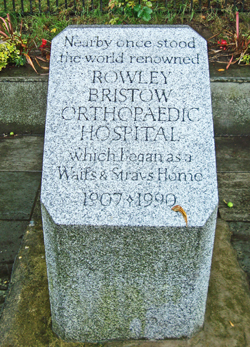
A granite stone commemorates the site of the former Hospital.
It reads:
" Nearby once stood the world renowned Rowley Bristow Orthopaedic Hospital, which began as a Waifs and Strays' Home
1907 - 1990"
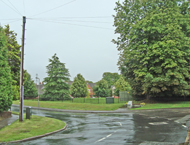
The commemorative stone, laid in 2003, is located at the corner of Sandy Lane and Floyds Lane.
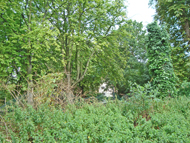
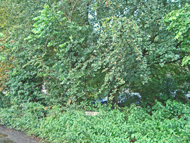
The site of the main entrance drive to the St Nicholas' Home and later the Hospital on Sandy Lane.
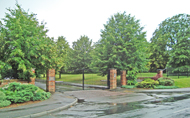
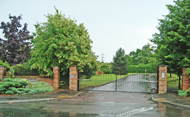
St Nicholas Crescent lies roughly on the site of the original buildings of St Nicholas Home.

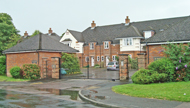
St Martin's Mews had been built roughly on the site of St Martin's Home.
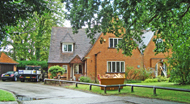
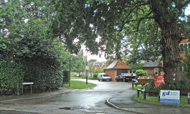
The former lodge to St Martin's Home has survived (left). Rowley Close, on the east of the site, is near the original driveway to St Martin's Home (right).
(Author unstated) 1908 Home for Crippled Children. British Journal of Nursing, 8th August, 118.
(Author unstated) 1930 The hospital world. British Journal of Nursing (March), 82.
(Author unstated) 1948 Medical News. Rowley Bristow Orthopaedic Hospital. British Medical Journal 1 (4540), 82.
http://en.wikipedia.org
http://wokinghistory.org
www.britishpathe.com
www.exploringsurreyspast.org.uk (1)
www.exploringsurreyspast.org.uk (2)
www.hiddenlives.org.uk (1)
www.hiddenlives.org.uk (2)
www.hiddenlives.org.uk (3)
www.nationalarchives.gov.uk
www.pyrford.com
Return to home page